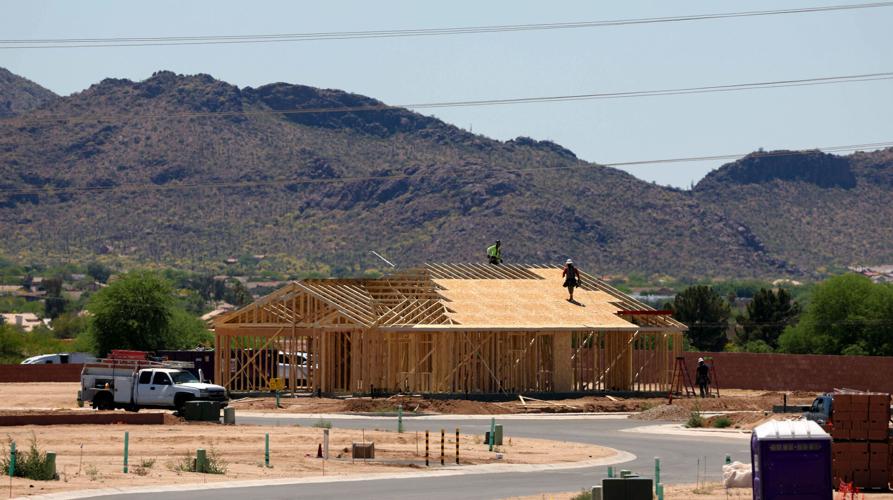After soaring above the $500,000 mark last spring, average new home prices in the Tucson market have leveled off.
Bucking the national trend of climbing prices for the past six months, Tucson’s average new home prices have held steady under $500,000 with smaller lots, less amenities and homebuilder financing programs contributing to cost reductions.
But the demand for housing locally is fueling new developments and the first quarter of the year saw the number of permits for new homes jump more than 100%.

Construction continues inside of the KB Home Colina de Anza Agave neighborhood, 5488 W. Monterey Drive, in Marana.
Meanwhile, existing homeowners continue to stay put and hold onto their low interest rates.
When that combination of factors could lead to average new home prices again exceeding $500,000 is anyone’s guess.
“Your local economy is going to dictate that breaking point,” said Tucson housing analyst Jim Daniel with R.L. Brown Reports. “New homes are taking advantage of what’s going on in the resale market and I don’t see that changing.”
In the first quarter of 2023, homebuilders pulled 605 permits for new homes and in the same timeframe this year, that number rose to 1,268, R.L. Brown Report data shows.
Daniel said interest rates aren’t expected to decrease, which means investor interest in gobbling up existing homes has been diminished.
“There’s a sector of the housing market that has been sitting on the sidelines and that’s the investors,” he said. “Having them sit out has been positive for prices, but if interest rates go back down, investors will be back.”
Keeping up with demand

KB Home has been a leading homebuilder by keeping prices in the upper $200,000 to mid-$300,000 range.
New home building is especially active at the developments Blackhawk — near Interstate 10 and Wilmot Road, Rocking K — near Old Spanish Trail on the city’s east side, and Barnett Village — off Sanders Road in Marana.
The top five builders, in terms of volume, are D.R. Horton, Lennar Homes, Meritage Homes, Pulte Homes and KB Home.
KB Home has been a leading homebuilder by keeping prices in the upper $200,000 to mid-$300,000 range and currently has 11 new home communities open for sale or under construction, said Amy McReynolds, president of KB Home’s Tucson division.
“In 2024, we expect to accelerate our land investment activity to support our future growth while remaining diligent with respect to our product strategy and price points,” she said.
KB Home’s built-to-order models means buyers can get into a starter home and upgrade in the future, which helps keep costs down by choosing less expensive countertops, cabinets and light fixtures, for example.
“This is an exciting time for KB Home’s Tucson division,” McReynolds said. “Our business is well situated to respond to strengthening buyer demand and favorable demographics in the market, given our product positioning and affordable price points as well as planned community count growth.”
Like many homebuilders, KB Home works with lending partners to offer lower mortgage rates for qualified buyers.
Daniel said that is a key difference to today’s housing situation, versus the times leading up to the housing crash where some unqualified buyers were approved for a home.
“The mentality that everybody deserves to live in a house is gone,” he said. “You have to put money down, you have to qualify, you have to have skin in the game.”
He said buyers’ expectations have also adjusted.
“Remember the starter home?” Daniel asked. “When you bought the stripped-down version of a house, and you added upgrades when you were ready?”
More homebuyers are realizing that upgrades in flooring and luxury faucets can wait to get into a simple home in a location that might not be their first choice. Sprawling backyards are also giving way to more interior space on smaller lots.
According to the U.S. Census Bureau, lot sizes for new homes have decreased from an average of 10,500 square feet to about 8,700 square feet in the past decade.
Overall, Daniel said, the housing situation in the Tucson market is “positive” compared to other parts of the country where home prices are still rising.
“I wish we could just chop the COVID years off of everything,” Daniel said of the price increases during the pandemic. “People would see it’s been a steady market.”





